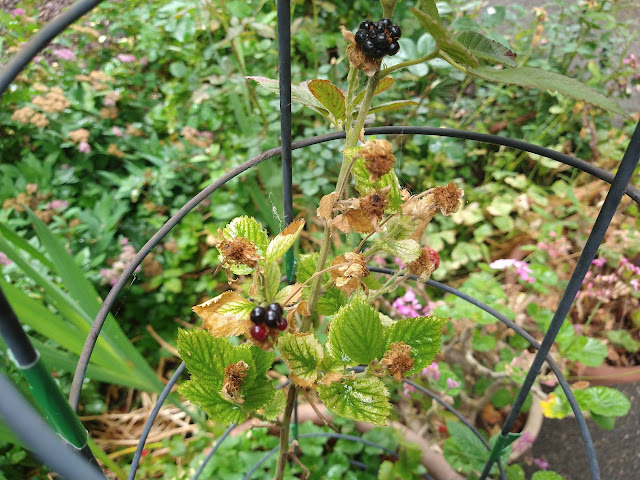
Poor blackberry pollination can be traced to spring weather

|
|
This Babycakes blackberry, a patio-size plant, produced just a few misshapen
berries this spring. Weather played a large part in the problem. (Photo: Debbie
Arrington)
|
This berry season, the bees let me down. My usually dependable blackberry plants bore precious few berries. The ones that did develop turned out misshapen. Instead of clusters of berries, the canes were covered with dried-up brown stubs.
I had lots of flowers – beautiful white blooms that usually attract bees with no problem. My blackberries grow near a big bed of roses; bringing pollinators into my backyard has never been a problem.
But this spring was different. In particular, my Babycakes dwarf blackberries fell victim to rollercoaster temperatures. Early April warmth (including 92 degrees on April 8) brought out the first berry blooms. But that was followed by a sudden plunge back into the 50s and frost on April 12. That sudden, unseasonable frost may have snuffed out pollinated blooms.
Once the flowers open, their stamens and pollen stay viable for only a short period (usually three days); they need bees when they need them. Honeybees don’t like wildly fluctuating temperatures. They don’t come out when it’s too cold or too hot, and it was both while those berries needed their help.
So the little pollination that did happen was extremely spotty; my guess, it was self-fertilization, not bees.
Adding to the berry dilemma were heat and drought, especially in June as berries were ripening.
Sacramento set a record for most 100-plus days in June; 11 days hit triple digits including a streak of eight straight. Three June days reached 104. That put heat stress on plants as berries were developing.
Vines already were thirsty. The last six months have been almost bone-dry, and even those notoriously vigorous blackberry roots were subject to dieback. Unless plants got supplemental irrigation, the vines tended to brown and often aborted berry production. (My Babycakes plant has the added challenge of growing in a large pot.)
And it’s not just my poor Babycakes that’s suffering. I’ve seen a similar lack of pollination and vine dieback in blackberries in our local greenbelt.
Fortunately, my vines are already sprouting healthy green growth. It’s time to cut out the old canes with their brown stubble, and move on. Maybe I can get a fall harvest? We’ll see what the bees are doing in August.
For more on blackberries and other caneberries, here are UC cultivation notes: https://www2.ipm.ucanr.edu/agriculture/caneberries/Growth-and-Development/ Also, here's good information from the Sacramento County master gardeners on growing caneberries in our region: https://ucanr.edu/sites/sacmg/files/74193.pdf
Comments
0 comments have been posted.Sacramento Digs Gardening to your inbox.
Food in My Back Yard Series
April 1: Don't be fooled by these garden myths
March 25: Fertilizer tips: How to 'feed' your vegetables for healthy growth
March 18: Time to give vegetable seedlings some more space
March 11: Ways to win the fight against weeds
March 4: Potatoes from the garden
Feb. 25: Plant a fruit tree now -- for later
Feb. 18: How to squeeze more food into less space
Feb. 11: When to plant? Consider staggering your transplants
Feb. 4: Starting in seed starting
Sites We Like
Garden Checklist for week of March 30
Your garden doesn’t mind April showers. Get busy now to enjoy those future flowers.
* Get ready to swing into action in the vegetable garden. As nights warm up over 50 degrees, start setting out tomato, pepper and eggplant transplants.
* From seed, plant beans, beets, cantaloupes, carrots, corn, cucumbers, melons, pumpkins, radishes and squash. (Soak beet seeds overnight in water for better germination,)
* Plant onion sets.
* In the flower garden, plant seeds for asters, cosmos, celosia, marigolds, salvia, sunflowers and zinnias.
* Transplant petunias, zinnias, geraniums and other summer bloomers.
* Plant perennials and dahlia tubers for summer bloom.
* Transplant lettuce and cabbage seedlings.
* April is the last chance to plant citrus trees such as dwarf orange, lemon and kumquat. These trees also look good in landscaping and provide fresh fruit in winter.
* Smell orange blossoms? Feed citrus trees with a low dose of balanced fertilizer (such as 10-10-10) during bloom to help set fruit. Keep an eye out for ants.
* Apply slow-release fertilizer to the lawn.